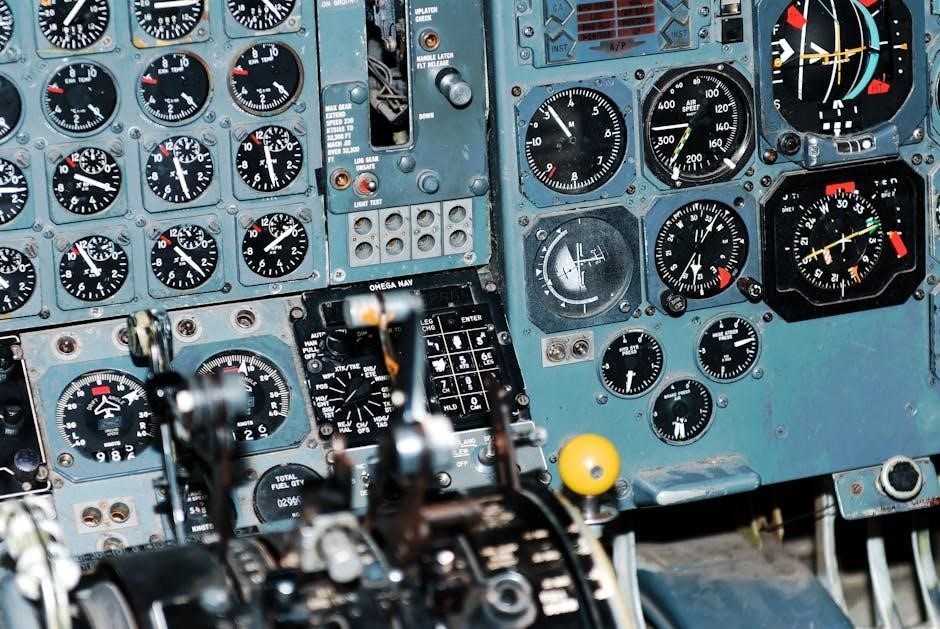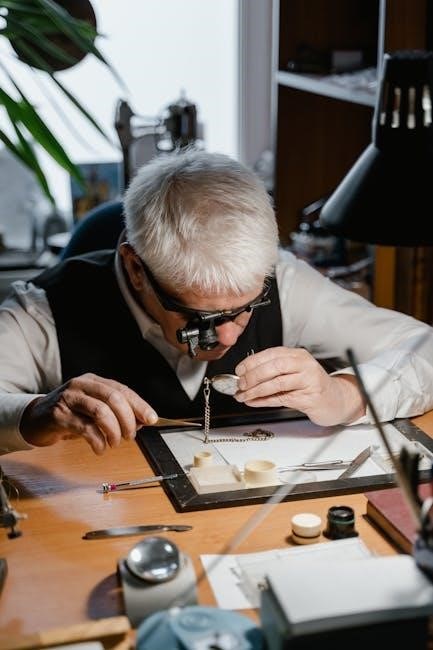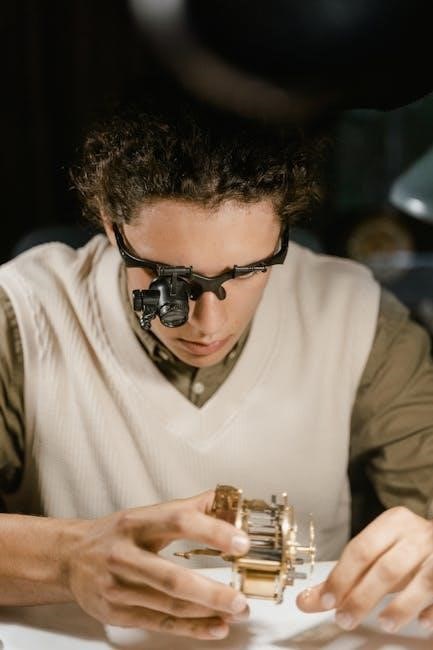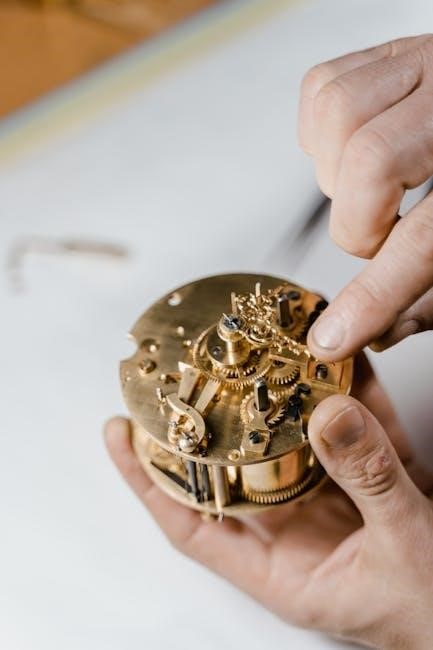Manual clocks have a rich history, with mechanical parts and spring drives, they are still used today, a testament to their enduring appeal and functional beauty always.
Definition and Purpose
A manual clock is a type of timekeeping device that requires manual winding or setting to operate, as opposed to automatic or quartz clocks. The purpose of a manual clock is to display the time in a mechanical and traditional way, often with a focus on aesthetics and craftsmanship. Manual clocks can be found in various forms, including wall clocks, grandfather clocks, and pocket watches. They are often used to add a touch of elegance and sophistication to a room or outfit. The definition of a manual clock is closely tied to its mechanical nature, with intricate gears and springs working together to measure time. Overall, the purpose of a manual clock is to provide a unique and functional way to tell time, while also serving as a decorative piece. Manual clocks are still widely used today, and their beauty and functionality continue to be appreciated by many.
History of Manual Clocks
The history of manual clocks dates back to ancient civilizations, with early examples of timekeeping devices found in Egypt, Greece, and Rome. These early clocks were often large and cumbersome, using sundials or water clocks to measure time. As technology improved, manual clocks became more sophisticated, with the introduction of mechanical clocks in the Middle Ages. The first mechanical clocks were powered by weights and pulleys, and were often found in town squares and churches. Over time, manual clocks evolved to include more intricate mechanisms and decorative features, such as carvings and engravings. The development of manual clocks continued through the Renaissance and beyond, with the creation of precision timepieces and the introduction of new materials and manufacturing techniques. Today, manual clocks remain a popular choice for those who appreciate traditional craftsmanship and the unique character of mechanical timekeeping. Manual clocks have a rich and fascinating history that spans thousands of years.

Components of a Manual Clock
Manual clocks consist of various mechanical parts, including gears, springs, and escapements that work together to measure time accurately always with precision and functionality.
Movement Diagram and Mechanism
A manual clock’s movement diagram illustrates the intricate mechanism of gears, springs, and escapements that work together to measure time. The motive power, typically a mainspring, is released through a series of gears, turning the clock’s hands. A flywheel and rack system help regulate the movement, ensuring accurate timekeeping. The movement diagram also reveals the clock’s striking mechanism, which chimes the hours and half hours. Understanding the movement diagram and mechanism is essential for clockmakers and enthusiasts, as it allows them to appreciate the complexity and beauty of manual clocks. By studying the movement diagram, one can gain insight into the clock’s inner workings and develop a deeper appreciation for the craftsmanship that goes into creating these timepieces. The movement diagram is a crucial component of a manual clock, and its complexity is a testament to the ingenuity of clockmakers.
Clock Heads and Wall Clock Movements
Manual clock heads and wall clock movements are essential components of timekeeping devices. Clock heads refer to the visible face of the clock, displaying hours, minutes, and sometimes seconds. Wall clock movements, on the other hand, refer to the internal mechanism that powers the clock’s hands. These movements can be mechanical or quartz-based, each with its own unique characteristics. Clock heads can be customized with various designs, shapes, and sizes to suit different decor and styles. Wall clock movements can also be replaced or repaired, extending the lifespan of the clock. The combination of clock heads and wall clock movements creates a functional and aesthetically pleasing timekeeping device. By understanding the different types of clock heads and wall clock movements, individuals can make informed decisions when selecting or repairing a manual clock. This knowledge can also help in appreciating the craftsmanship and complexity of manual clocks.

Types of Manual Clocks
Manual clocks include grandfather, mantle, and cuckoo clocks, each with unique characteristics and functions always requiring manual winding and setting properly.
Grandfather Clocks and Their Setup
Grandfather clocks are a type of manual clock that requires careful setup and maintenance, including proper winding and adjustment of their mechanical movements. The setup process typically involves attaching the clock mechanism to the clock case, and then adjusting the clock’s hands and chimes to ensure accurate timekeeping. Additionally, the clock’s weight and pulleys must be properly installed and adjusted to ensure smooth operation. A grandfather clock’s setup can be a complex process, requiring patience and attention to detail, but the end result is a beautiful and functional timepiece that can be enjoyed for generations. With proper setup and maintenance, a grandfather clock can provide years of reliable service, keeping perfect time and striking its chimes on the hour.
Quartz-Movement Based Perpetual Calendar Clocks
Quartz-movement based perpetual calendar clocks are a type of manual clock that combines the accuracy of quartz movement with the functionality of a perpetual calendar. These clocks use a quartz crystal to regulate their timekeeping, and a complex mechanism to display the date, day of the week, and month. The perpetual calendar function automatically adjusts for leap years and months with different numbers of days. Quartz-movement based perpetual calendar clocks are highly accurate and require minimal maintenance, making them a popular choice for those who want a reliable and functional timepiece. They are often used in official and professional settings, where accuracy and reliability are crucial. With their advanced features and accurate timekeeping, quartz-movement based perpetual calendar clocks are a great option for anyone looking for a high-quality manual clock. They are also available in a variety of styles and designs.

Assembly and Repair
Manual clock assembly and repair require technical skills and specialized tools always needed.
Step-by-Step Assembly Guide
A step-by-step assembly guide for manual clocks is essential for ensuring that all components are properly installed and functioning correctly. The guide typically begins with the assembly of the clock’s mechanical movement, which involves attaching the gears and springs to the main plate. Next, the clock’s hands and dial are attached, followed by the installation of the clock’s striking mechanism, if applicable. The guide also covers the assembly of the clock’s case and the attachment of the clock’s pendulum, if it is a weight-driven clock. By following the guide, clock makers can ensure that their manual clocks are assembled correctly and will keep accurate time. The guide is usually accompanied by diagrams and illustrations to help clarify the assembly process. Clock makers can find these guides online or in clock making books and manuals. The process requires patience and attention to detail.
Replacing Battery-Operated Clock Works

Replacing battery-operated clock works is a relatively simple process that can be done with basic tools. The first step is to remove the old clock mechanism from the clock case, which usually involves removing a few screws. Next, the new clock mechanism is installed, making sure that it is properly seated and secured. The clock’s hands are then reattached to the new mechanism, and the clock is tested to ensure that it is keeping accurate time. The process typically takes only a few minutes to complete, and can be done by anyone with basic DIY skills. Clock makers can find replacement clock mechanisms online or at clock making supply stores. The new mechanism is usually packaged with instructions and diagrams to help guide the replacement process. By replacing the old mechanism, clock owners can restore their timepiece to its original functionality and accuracy. Clock works replacement is a common maintenance task.
Manual clocks remain relevant today, with their timeless appeal and functional beauty always enduring and cherished by many people everywhere.
Importance of Manual Clocks in Modern Times
Manual clocks continue to hold significance in modern times, with their unique blend of tradition and functionality. They serve as a reminder of the past, while also providing a sense of nostalgia and character to any room. Many people appreciate the aesthetic value of manual clocks, with their intricate mechanisms and beautiful designs. Additionally, manual clocks can be a valuable tool for teaching children about time and responsibility. They also promote a sense of community, as people gather to wind and maintain them; Furthermore, manual clocks can be a symbol of heritage and cultural identity, with many historic clocks still in operation today. Overall, manual clocks remain an important part of our cultural landscape, providing a connection to the past while also continuing to serve a practical purpose in the present, with their importance still felt today everywhere.

Be First to Comment